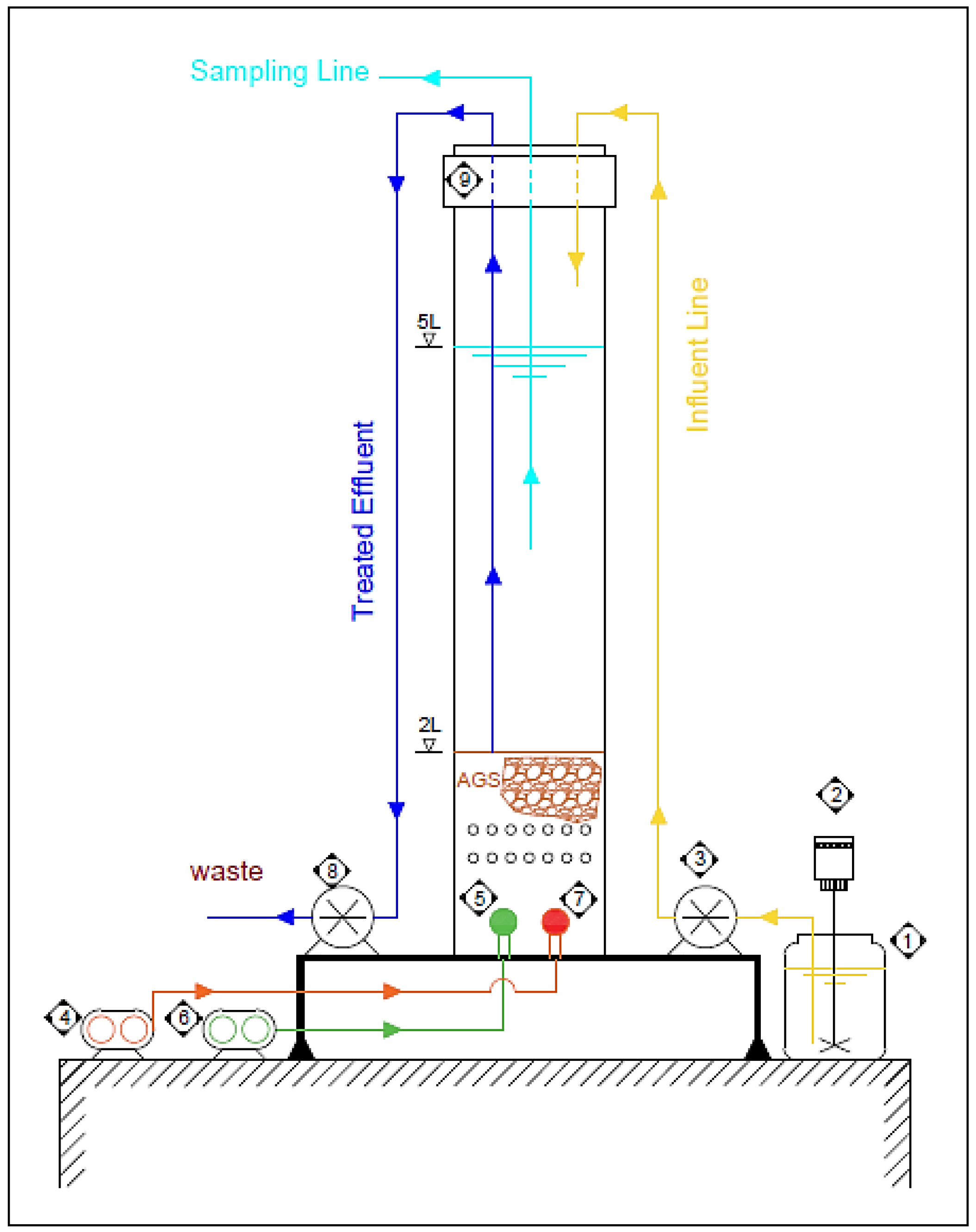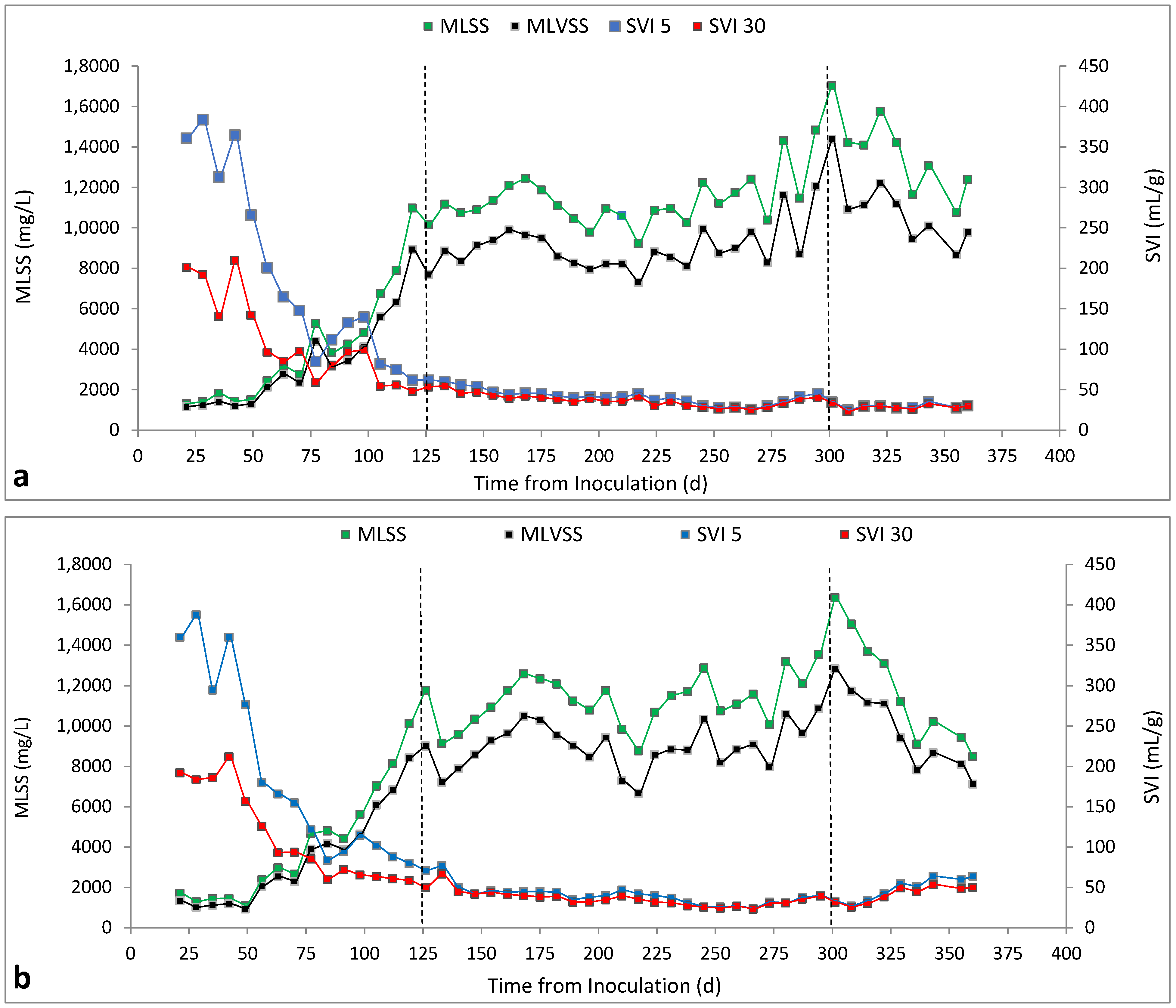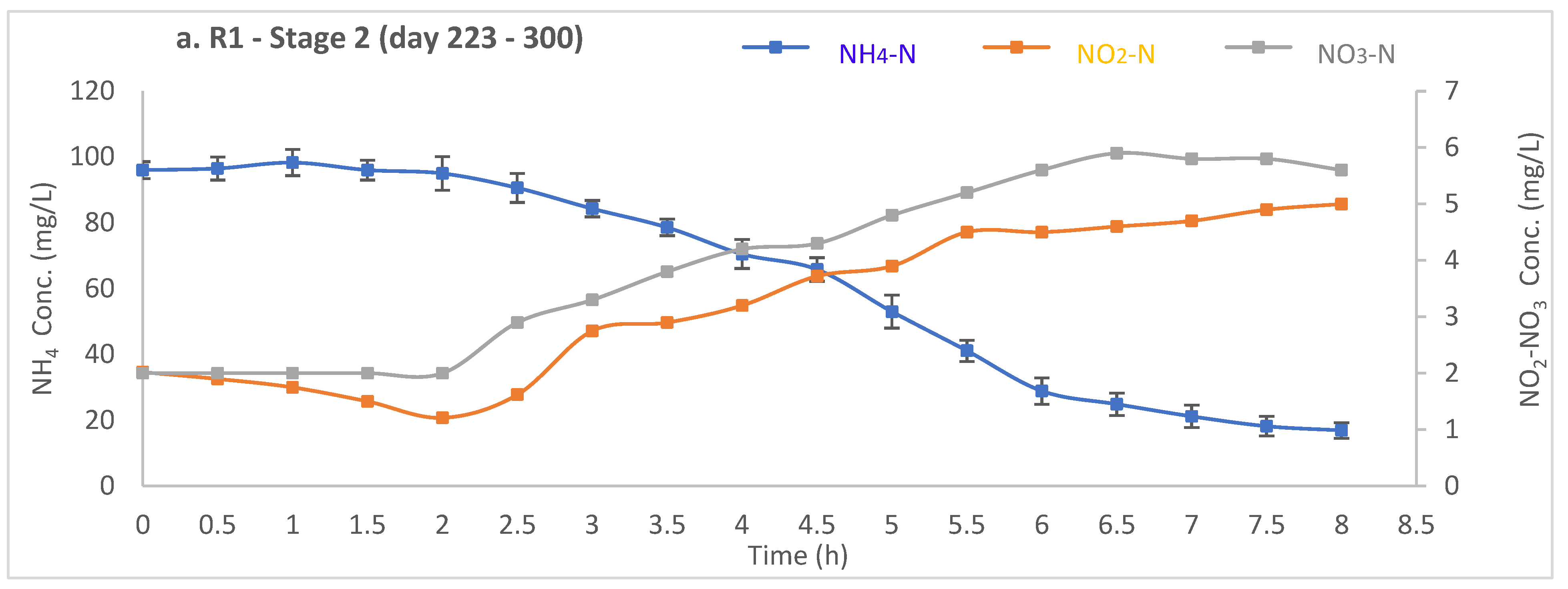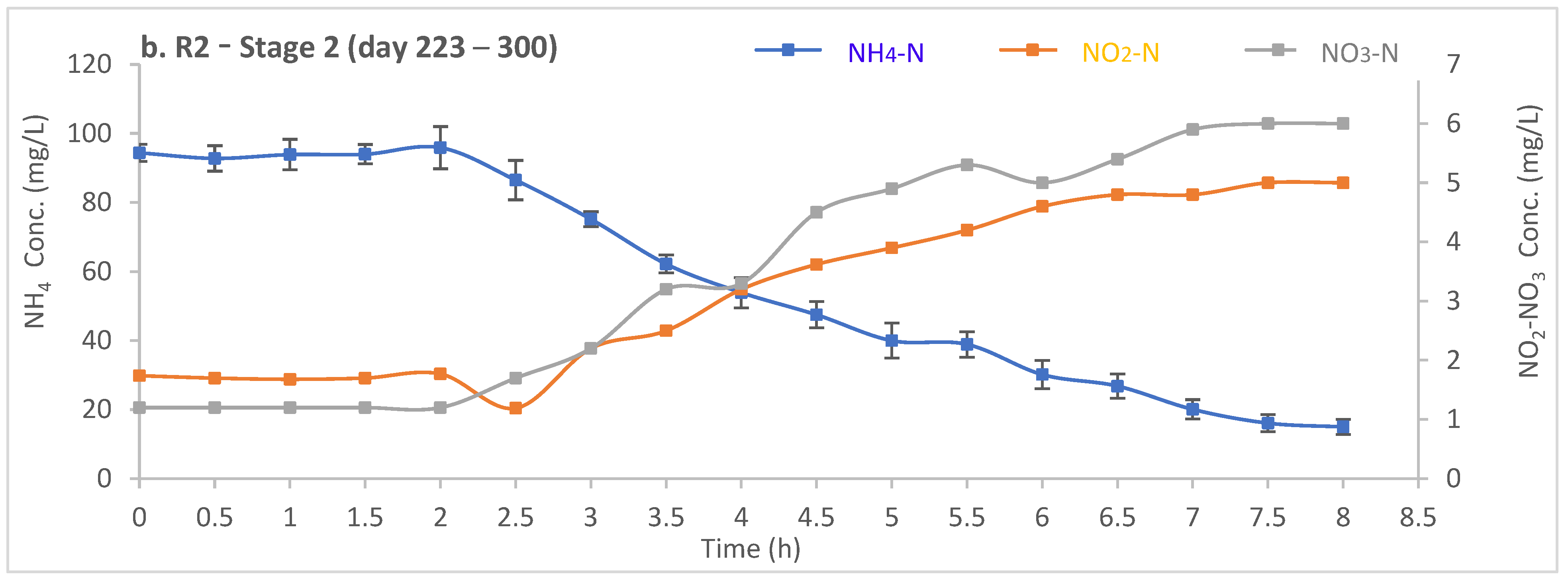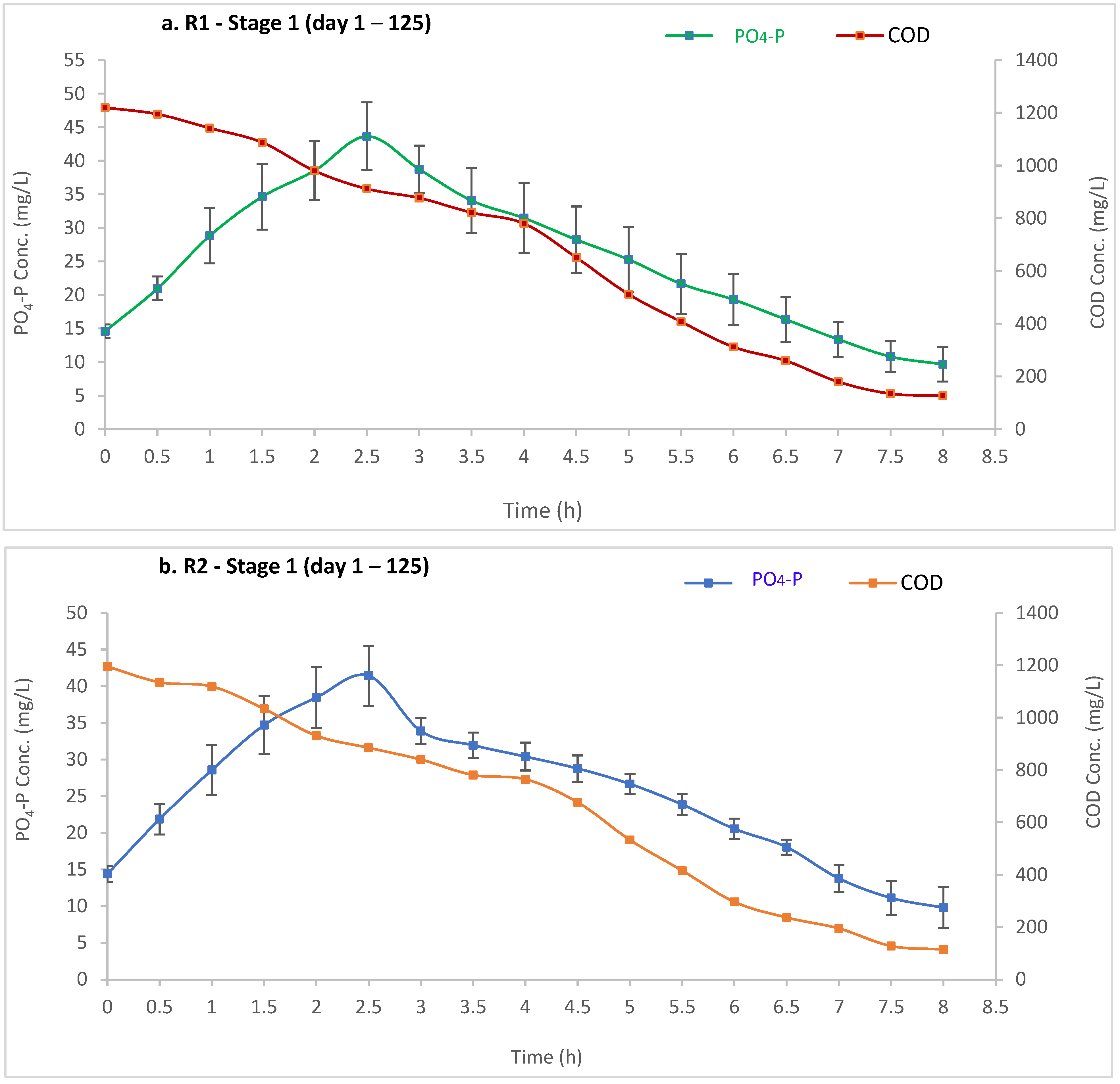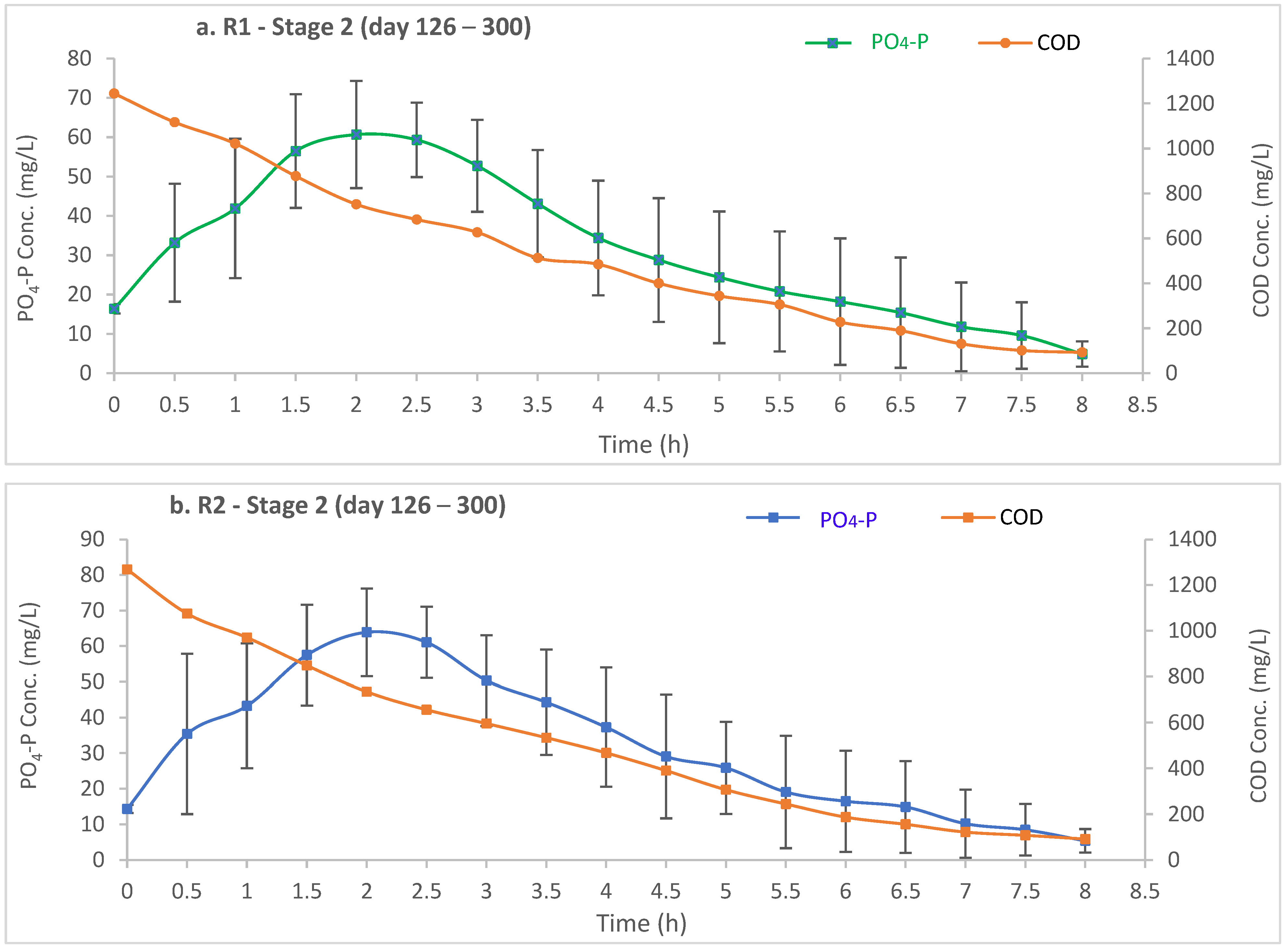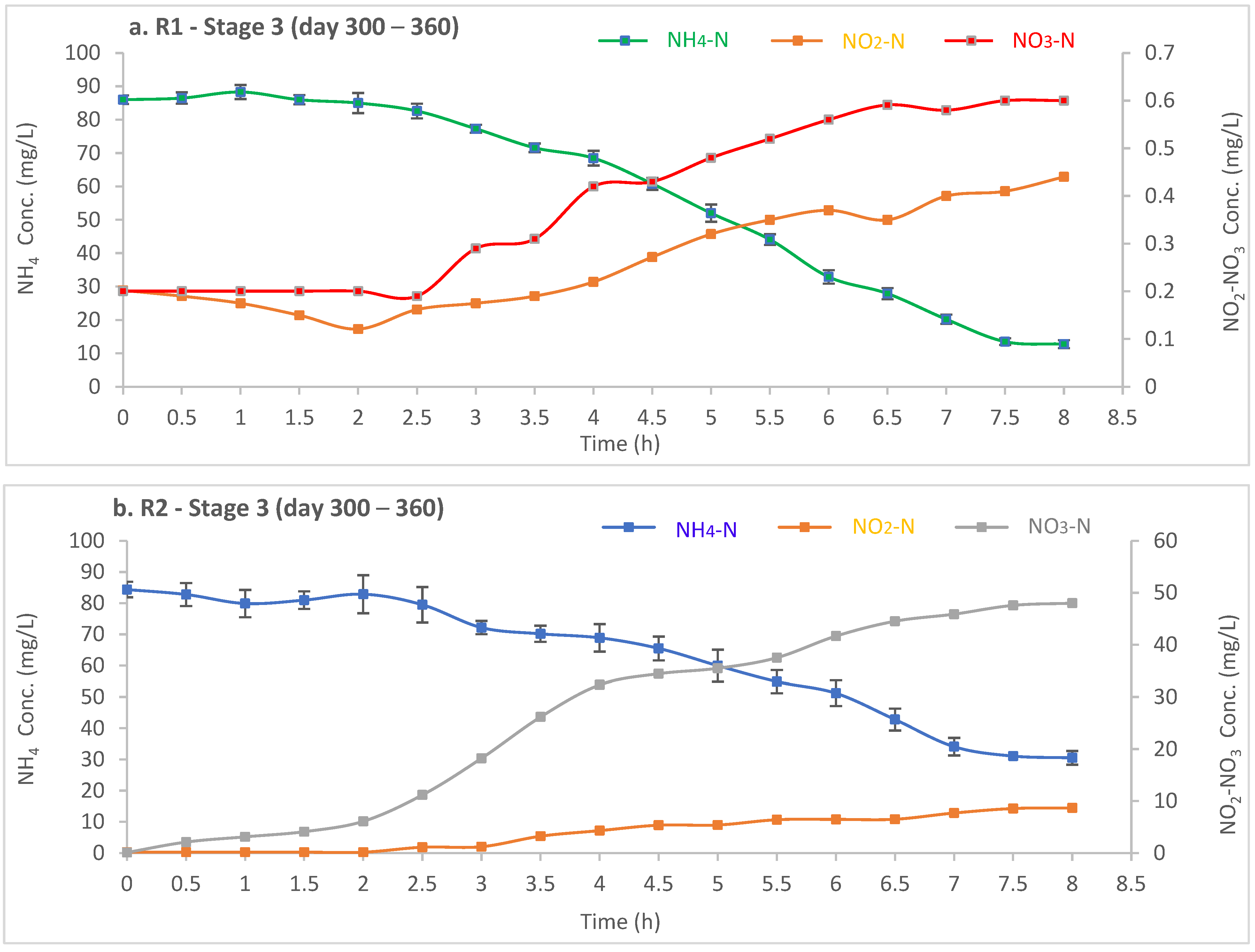1. Introduction
Recently, aerobic granular sludge (AGS) has gained popularity among researchers due to its superior properties as compared to conventional activated sludge (CAS). AGS is an economically and environmentally promising replacement for CAS, for purification of different types of wastewaters (e.g., municipal and heavily loaded industrial wastewater) [
1]. Layered structure of AGS is known for high removal performance of different nutrients via multiple biological processes (e.g., nitrification and denitrification) occurring in a single tank [
2]. AGS system has biofilms composed of auto-immobilized cells that are generated during treatment in a sequencing batch reactor (SBR), where the clarifier is eliminated, and a settling phase is included in the reactor schedule. Thus, a return activated sludge line is not applicable, depending on the amount of biomass retained in the reactor after decanting. By switching to aerobic granulation system, daily produced biomass is also decreased leading to reduction in the overall cost of up to 25% and energy requirement up to 30% [
3]. Since the inception of AGS in the late 1990s as an innovative technology [
3], it has been applied successfully for the treatment of different influents; however, there are some unresolved problems such as granule disintegration, long period of granule formation when using sewage with high organic loads, and nitrite accumulation [
4].
The literature review findings show the cultivation of AGS in SBR by investigating the impact of various operational parameters that can control the granulation process (i.e., formation and stability), such as alternating feast and famine conditions, reactor configuration (height-to-diameter ratio, hydraulic retention time (HRT), and exchange ratio), hydrodynamic shear forces, influent characteristics (COD:TN:TP ratio), and influent distribution (influence the morphology and microbial community of AGS), selective wasting (in most GSBRs, settling time is the selection pressure for granulation process), organic loading rates, biomass characteristics, and other environmental factors (e.g., dissolved oxygen, pH, and temperature).
Different studies have reported varying conditions for the development of aerobic granulation process. For example, R.A. Hamza et al. (2018) investigated the long-term stability of AGS treating high organic loads through a semi-pilot scale SBR and found that F/M ratio has played a key role in the formation and stability of granules [
5]. At F/M ratios between 0.5 and 1.4 gCOD/gVSS∙d, stable granules with excellent settleability were maintained, while fluffy granules were caused when the F/M value exceeded 2.2 gCOD/gVSS∙d. Another study demonstrated that utilizing longer HRT caused a reduction in the applied OLR, which was found to be more effective for granulation process by providing longer starvation time [
6].
Stable AGS was achieved successfully in a previous study by applying low hydrodynamic shear (0.4 cm/s) [
7]. In addition, successful removal of the fast-growing organisms (e.g., ordinary heterotrophic organisms (OHO)) from granules’ surface has been achieved by applying higher hydrodynamic shear [
8,
9].
A lot of challenges are related to an efficient and continuous application of the obtained mature granules in the treatment processes. For example, causes of granule instability have also been studied and linked to a range of factors such as: proliferation of filamentous bacteria at high OLR [
8,
9], as well as decrease and destruction in the structure of extracellular polymeric substances (EPS), with the decrease in protein-to-carbohydrate ratio (proteins play an essential role in granule stability) [
10,
11,
12]. EPS in the aerobic granulation process, acts similarly to a ‘glue’ to induce biofilm formation among the microorganisms, where EPS are synthesized as a derivative of organic compounds, such as proteins, polysaccharides, lipids, glycoproteins, nucleic acids [
13,
14]. It depends on several factors, including aeration time, cycle duration, superficial air velocity, reactor conditions, and type of inoculum sludge that affect the production and composition of EPS.
Feeding mode is one of the key factors in the selection, formation, and stability of AGS. GSBRs are categorized into two types: continuously aerated, and anaerobic influent distribution. Anaerobic filling in GSBR has been widely accepted, in which the duration and influent load are considered efficiency determining factors. A few previous studies have demonstrated that step-feeding can be an efficient strategy to remove organic matter and nutrients simultaneously, especially with great potential to favor granulation in effluents with high OLRs (e.g., sanitary landfill leachate and high-strength industrial discharges). For example, another previous study has evaluated the effect of filling mode on the performance and granules’ operational stability to treat high-strength ammonium concentrations through three SBRs: R1, fast feeding in the anaerobic period (20 min); R2, slow feeding in the anaerobic period (40 min); and R3, distribution of feeding throughout the cycle [
15]. Results of step-feeding in R3 were the best, where the problems such as granules stability, biomass retention, and nitrite accumulation were minimized while treating leachate, as well as higher nutrients removal efficiencies were achieved compared to R1 and R2. In addition, the results from this study showed the positive impact of applying the strategy of step-feeding in R3 compared to R1 and R2, where the approach of step-feeding distributed throughout the cycle of operation was an excellent method to develop the sedimentability of biomass. Moreover, this strategy enhanced the proliferation of slow-growing organisms through the prevention of growing ordinary and fast-growing heterotrophic bacteria [
15].
The effect of different feeding strategies on the proliferation dynamics of polyphosphate-accumulating organism (PAOs) and phosphorus removal has also been investigated [
16]. Herein, three feeding strategies (e.g., anaerobic slow feeding, pulse feeding followed by anaerobic mixing, and pulse feeding) were applied through GSBRs. The obtained results show that feeding strategies had no impact on organic and ammonia removal and did not alter the microbial community. However, phosphorus removal performance has been significantly influenced. Reactors that have anaerobic slow feeding and pulse feeding followed by anaerobic mixing demonstrated high phosphorus recovery from wasted sludge; therefore, active PAOs can be accumulated, and GAOs can be significantly inhibited within the bioreactor leading to high specific phosphorus uptake and specific phosphorus release rates [
16].
To the best of our knowledge, there is no current information on the effect of applying anaerobic step feeding strategy on matured AGS cultivated and matured under the effect of treatment of high-organic loads in GSBRs systems at the same operational conditions. Thus, the aim of this work is to investigate the potential enhancement in the substrate and nutrients removal performance of large AGS after changing feeding strategy of these GSBRs from fast single feeding mode followed by anaerobic mixing to step-feeding distributed throughout the anaerobic stage, when applied under the same previous operational conditions for treatment of high-strength wastewater.
3. Results and Discussion
Firstly, there was a strong convergence in the results (as shown in
Table 2) such as physical properties (i.e., size, SVI
5, and SVI
30), and performance (i.e., removal of organics and nutrients) of R1 and R2 over a period of 300 days of operation after inoculation (through cultivation and maturation of AGS until changing the filling mode of R2 on day 301). This was due to both GSBRs operated under the same conditions (e.g., reactors configuration, design parameters, influent characteristics, seeding sludge, etc.).
The mean value of the measured pH through the anaerobic phase for both reactors during cultivation period (first 125 days after inoculation) was about 8.9, and it decreased through the aerobic phase to 8.2. During the maturation stage (day 126 to 300), these values were further decreased to 8.3 and 7.9 through the anaerobic and aerobic phases each cycle. It is worth mentioning that DO concentrations have been measured during the entire period of operation for both reactors in order to continuously monitor the aerobic and anaerobic conditions during operational cycles. DO concentrations during anaerobic phase did not exceed 0.1 mg/L, while it ranged between 4–5 mg/L during the aerobic phase. It is important to mention that the experiment was conducted at room temperature (18 ± 2 °C).
3.1. Granulation Processes
The seed sludge was dark brown in colour and had MLSS, mixed liquor volatile suspended solids (MLVSS), and SVI
30 of 8100 mg/L, 6955 mg/L, and 128 mL/g, respectively (average of triplicates samples), as well as a mean particle size of 115 μm. The two SBRs were initially operated with the same volume (2 L). During the acclimation period (15 days), the MLSS concentrations were gradually reduced in GSBRs accompanied with higher TSS
eff (974 ± 122 mg/L). The reason for this reduction is due to the impact of applying short sedimentation phase (10 min) during the cycle operation, which is considered as the selection pressure and a key strategy for developing aerobic granulation in order to wash out the poor settling biomass. However, after adaptation period and even after biomass stabilization, higher amounts of solids existed in the effluents. In other words, constant washout sludge was observed in R1 and R2. This is consistent with previous studies of AGS systems applied to treat high-strength wastewaters [
20,
21]. Factually, 75 days were estimated as a startup period for both reactors.
Biomass characteristics (MLSS, SVI
5, and SVI
30) for R1 and R2 are presented in
Figure 2 and
Table 3. As mentioned, MLSS concentrations continued to decrease in both reactors from the first day of operation until day 50. During the same stage, in terms of sedimentability and according to previous studies, various researchers demonstrated that the SVI
30/SVI
10 or SVI
30/SVI
5 ratios can be considered good indicators of granulation, meaning that a value closer to 1.0 indicates that the sludge consists mainly of mature granules [
22,
23,
24,
25]. It took about 63 days for flocculent sludge (SVI
30 more than 125 mL/g and SVI
30/SVI
5 ratio lower than 0.4) to convert to small aerobic granules, as shown in
Figure 2 (SVI
30 is 85 mL/g and SVI
30/SVI
5 ratio is 0.52 for R1, while SVI
30 is 93 mL/g and SVI
30/SVI
5 ratio is 0.56 for R2). Measurements of the size of AGS that were performed at day 50 were exceeded by 0.5 mm for R1 and R2, meeting the requirement for granular sludge. By the end of cultivation stage (day 125), biomass concentrations (MLSS) increased because of the granules’ superior settleability and high biomass density and reached 10 g/L and 11.8 g/L for R1 and R2, respectively, which is consistent with previous studies [
22]. Moreover, large AGS have been achieved in both GSBRs SVI
30 = 48.2 mL/g and SVI
30/SVI
5 ratio = 0.78 for R1, and SVI
30 = 58.5 mL/g and SVI
30/SVI
5 ratio = 0.73 for R2. While granules’ size reached more than 2.22 mm and 2.13 mm for R1 and R2, respectively, by day 125.
The biomass concentrations for R1 and R2 were 10,164 ± 111 mg/L and 9156 ± 157 mg/L, respectively, on day 125 (end of cultivation stage). During the following period (day 126–300), biomass accumulation continued and directly increased biomass concentrations for GSBRs.
Table 3 demonstrates the average MLSS concentrations during the whole maturation period. MLSS and MLVSS of both reactors are shown in
Figure 3. The rise in biomass concentrations were achieved during the same period on day 294, where the highest MLSS was 14,844 ± 78 mg/L for R1, and 13,564 ± 128 mg/L for R2. This is a direct result from continued biomass accumulation. In this context, there were fluctuations in the TSS
eff for R1 and R2 which can be attributed to applying shorter settling time (10 min) during the operational cycle (i.e., discharging of poor settling biomass selection pressure). The average concentrations of TSS
eff for R1 and R2 during cultivation period (1–125 day) were 180 ± 18 mg/L and 167 ± 15 mg/L, respectively (except the first 42 days after inoculation since there were high concentrations of TSS
eff and VSS
eff of reactors due to discharging the poor settling flocs). In addition, based on the concentration of TSS
eff and MLSS, the average solid retention time (SRT) was calculated during the cultivation period (day 15–125) of 18 ± 1 day and 16 ± 2 day for R1 and R2, respectively, while average SRT during the maturation stage (day 126–300) was 28 ± 2 day for R1 and R2 (
Table 3).
It has been demonstrated through several studies that higher F/M ratios favor formation and development of the AGS because of the enhanced EPS production [
12]. Therefore, it should be noted that through the first stage (cultivation stage—day 125) and under continuous treatment of high organic loads (2.25 Kg COD/m
3∙d), the gradual increase in the biomass concentrations (MLSS and MLVSS) might be the reason for the delay in the formation of large granules. F/M ratio decreased from 1.71 ± 0.11 gCOD/gVSS∙d for R1 and 1.35 ± 0.18 gCOD/gVSS∙d for R2 (at the beginning of cultivation period) to 0.29 ± 0.1 gCOD/gVSS∙d for R1 and 0.19 ± 0.12 gCOD/gVSS∙d for R2 (day 125). Consequently, this led to lower production of EPS compared to the following stage (maturation) as shown in
Table 3 and
Figure 3.
Regarding EPS, these components are biopolymers consisting of polysaccharides, proteins, and other substances, which play a crucial role in the granules’ structure, production, and stability. Several studies have shown that stable AGS have higher protein (PN) structures than polysaccharides carbohydrates (PS), and PN/PS ratio is a way of characterizing its stability [
14]. PN/PS ratio higher than 25 [
12], as well as lower values of 4.8 [
26] and 0.6 [
27,
28] have been reported. The concentrations of EPS are presented in
Figure 3. In the current study, EPS has been estimated as a combination of PN and PS. EPS ranged between 36 ± 1.1 mg/gVSS (PN/PS ratio of 1.11) for R1 and 31 ± 0.8 mg/gVSS (PN/PS ratio of 1.38) for R2 on day 28 and increased to 153.3 ± 4.8 mg/gVSS (PN/PS ratio of 4.3) for R1 and 172.7 ± 2.1 mg/gVSS (PN/PS ratio of 7.2) for R2 on day 120. Thus, the granules’ size (
Figure 4) increased during the same stage and reached 2.22 ± 0.13 mm for R1 and 2.13 ± 0.13 mm for R2. During the maturation period, there was a strong correlation of the average concentrations of EPS for both reactors. EPS for R1 and R2 were 203.7 mg/gVSS (average PN/PS ratio of 9.17) and 207.9 mg/gVSS (average PN/PS ratio of 9.51). Accordingly, the granules’ size (
Figure 4) was increased to about 3.02 ± 0.09 mm for R1 and 3.08 ± 0.06 mm for R2, respectively.
3.2. Performance of the Reactors
There was a strong correlation of the reactors’ performance in terms of sCOD, ammonium (NH4-N), nitrite (NO2-N), nitrate (NO3-N), and phosphorus (PO4-P) concentrations between R1 and R2 through cultivation and maturation stages (day 1–300). These results were expected because of the similar conditions of operation and same influent characteristics. Moreover, both reactors had good COD removal efficiency, but nitrogen and phosphorus removals were different and improved over time as mature granules were formed.
Both reactors exhibited high COD degradation, during the entire operational period (360 days: before and after changing filling mode for R2). R1 and R2 had mean removal efficiencies of 91.5± 2% and 91.2 ± 1%, respectively, during 360 operation days. This suggests that there was no effect of the feeding mode on the removal of organics. The results of COD removal efficiencies showed in this study are consistent with previous AGS systems that used both municipal and industrial wastewaters [
12,
29]. It should be noted that during the first stage (day 1–125: cultivation), R1 and R2 had mean sCOD concentrations in the effluent of 127.7 ± 24 mg/L and 115.4 ± 25 mg/L, respectively. While during maturation period as well as after changing the feeding mode of R2 (day 126–360), the mean sCOD concentrations in the effluent of R1 and R2 were estimated at 93 ± 14 mg/L and 91 ± 12 mg/L, respectively.
3.2.1. Ammonium Removal Performance
The average influent concentrations of ammonium were about 115.2 ± 4.6 mg/L (
Table 2). During the first 27 days and after two weeks of adaptation post inoculation (day 42), there were higher concentrations of ammonium in the effluents in both reactors. The mean value of NH
4-N removal efficiency was about 30% for GSBRs until day 42: NH
4-N concentrations in the effluents of R1 and R2 were found between 73 and 86 mg/L. After this point, an efficient ammonium oxidation was observed with NH
4-N removal efficiency of 51% and 55.9% for R1 and R2 at day 49, respectively. After that, a continuous gradual decrease in the NH
4-N concentrations of the effluents was observed until the end of the cultivation stage, where the mean values of 70.8 ± 1.5% and 69.6 ± 2.1% for R1 and R2 were found, respectively. Only nitritation (NH
4-N converted to NO
2-N) was observed, while full-nitrification ([a] NH
4-N oxidized to NO
2-N then [b] NO
2-N oxidized to NO
3-N) was not observed during this stage. This was indicated by the highest effluent concentrations of NO
2-N accompanied with lowest NO
3-N concentrations. At the end of this stage (day 120), effluent concentrations of NO
2-N were 62.3 mg/L and 58.4 mg/L for R1 and R2, while for NO
3-N concentrations were 4.4 mg/L and 7.3 mg/L for R1 and R2, respectively.
The potential reasons for this behavior might be due to the type of the inoculated sludge that used for both reactors at the beginning of operational period. Moreover, the lower sludge age that estimated for GSBRs during the first stage based on the MLSS and TSS
eff concentrations have played a direct role in the difficulty of the proliferation of slow-growing organisms (e.g., ammonia oxidizing bacteria (AOB), and nitrite oxidizing bacteria (NOB)). SRT for R1 and R2 have been estimated by 18 ± 1 and 16 ± 2 days, respectively. In addition, applying higher OLR (2.25 Kg COD/m
3∙d) might be considered one of the potential reasons caused these low efficiencies towards the NH
4-N removal through increasing the possibility of fast-growing, heterotrophic bacteria growing on granule’s surfaces. Besides, applying higher influent NH
4-N concentrations (120 ± 3.4 mg/L) was one of the reasons of lower performance of ammonium removal. Previous study [
12], has demonstrated that an improvement through the nitrification process has been achieved through a reduction in influent NH
4-N from 140 to 80 mg/L. This enhancement in the nitrification process for GSBRs has been confirmed through a gradual decrease in the effluent NO
2-N to less than 1 mg/L accompanied with gradual increase in NO
3-N from 35 to 48 mg-N/L.
During the maturation stage (day 126–300), NH4-N removal efficiencies for R1 and R2 have gradually increased due to accumulation growth of nitrifiers (AOB and NOB) as well as the average SRT during this stage increased and reached 28 ± 2 days for both R1 and R2. The average NH4-N concentrations in the effluent of R1 and R2 were estimated at 20.4 ± 1.4 mg/L and 18.8 ± 2.2 mg/L, respectively. Basically, the performance of GSBRs in NH4-N removal through maturation period can be discussed considering the following three phases:
- (a)
The commencement of full nitrification, and gradual enhancement in ammonium oxidation was observed between days 130 and 178. Reduction in effluent concentrations of NH4-N from 24.8 ± 1.7 mg/L and 27.7 ± 1.6 mg/L to 16.7 ± 2.4 mg/L and 15.5 ± 3.1 mg/L for R1 and R2, respectively, was estimated, and these reductions were accompanied with the reduction in NO2-N concentrations with simultaneous increase in NO3-N concentrations in the effluent. By day 178, effluent concentrations of NO2-N decreased and reached 16.7 ± 3 mg/L and 19.1 ± 1.2 mg/L for R1 and R2, respectively, while effluent concentrations of NO3-N increased to 45 ± 9 mg/L and 49.4 ± 12 mg/L for R1 and R2, respectively.
- (b)
From day 179 to 222, active and efficient full nitrification of the oxidized ammonium is observed in addition to the continuous reduction in effluent concentrations of NO
2-N, which have been decreased to 7.9 ± 1.2 mg/L and 10.4 ± 0.3 mg/L for R1 and R2, respectively. In addition, there was a reduction in the effluent concentrations of NO
3-N during the same period, and these concentrations reached about 18 ± 0.7 mg/L and 22.4 ± 1.8 mg/L for R1 and R2, respectively. It is worth mentioning that the decreasing in nitrate concentrations accompanied to the reduction in nitrite was due to the action of simultaneous nitrification-denitrification (SND), which will provide an important benefit to the GSBRs system by preventing the accumulation of nitrite and nitrate. The potential reasons for this can be characterized by the compact layer structure of the mature granules and the size of these AGS that can extend beyond 2.6 ± 0.06 mm for R1 and R2 (
Figure S2c,d—Supplementary File).
- (c)
Both reactors exhibited a good tendency to perform SND process for the rest of this stage, between days 223 and 300, (which was confirmed by the results of the kinetic tests as shown in
Figure 4a,b) through noticeable reduction in the effluent concentrations of NO
2-N and NO
3-N. However, the effluent concentrations of NO
2-N and NO
3-N for reactors reached more than 6 mg/L and 10 mg/L, respectively. In addition, it should be noted that the removal efficiency of NH
4-N by the end of the maturation stage (day 300) was estimated for R1 and R2 as 85.5 ± 1.8% and 87.1 ± 1.6%, respectively, (NH
4-N concentrations in the effluents ranged between 15 and 20 mg/L).
Accordingly, and based on the levels of nitrite and nitrate in the effluent, a new operational stage (stage III) was planned to investigate the possibility of the enhancement of denitrification process for reactors and minimizing both of nitrite and nitrate accumulation. Thus, feeding strategy was changed to anaerobic step-feeding for R2 only to investigate its influence and feasibility on the enhancement of the denitrifiers performance, while R1 was operated under the same conditions during the previous 300 days. In addition, and because of the low efficiency of phosphorus removal for GSBRs (about 75% as shown in the following section), studying the impact of changing filling mode on the activity of PAOs will be investigated. Results for GSBRs are discussed in the following section.
3.2.2. Phosphorus Removal Performance
The average influent concentration of PO
4-P was 17.02 ± 0.9 mg/L (
Table 2). Until the stage of cultivation (day 125), lower efficiencies of phosphorus removal for GSBRs were observed. The mean phosphorus removal efficiencies for R1 and R2 were 42.8 ± 5.9% and 42 ± 7.2%, respectively. The potential reasons for these lower efficiencies can be insufficient carbon source (COD = 1250 ± 43 mg/L) for PAOs in the influents (COD:TN:TP ratio is 25:3:1). Thus, there will be a competition of carbon uptake during anaerobic stage (1.5 h) in the operational cycle (8 h) between these PAOs and other denitrifiers. However, higher efficiencies of phosphorus removal have been observed for R1 and R2. For instance, phosphorus removal efficiency for R1 and R2 were estimated at 75 ± 1.4% and 77.2 ± 0.9% at day 98.
The seed sludge used in the reactors played a role in the enhancement of phosphorus removal after inoculation in GSBRs and especially during the initial days in cultivation stage (i.e., before formation of large granules) because it was RAS from a BNR wastewater treatment plant. Kinetic tests shown in
Figure 5a,b demonstrated relatively lower rates of the anaerobic phosphorus release (4.4 mg-P/gVSS and 4.1 mg-P/gVSS, for R1 and R2, respectively) and slightly higher aerobic phosphorus uptake (6.5 mg-P/gVSS and 6.7 mg-P/gVSS, for R1 and R2, respectively) during the cultivation stage. Phosphorus content in the biomass at the end of an operational cycle was observed at lower concentrations of 72 mg-P/gVSS as a mean value during the first 125 days of operation. The lower phosphorus removal in both reactors implies that the layered structure of the formed AGS (with an aerobic outer layer and an anaerobic core) at this stage (size of granules was about 2 mm) was insufficient to allow anaerobic phosphorus release and efficient phosphorus uptake. Low phosphorus removal was previously reported in GSBRs systems [
30]. Comparable results were found by Iorhemen, O.T et al. (2022) [
16], where three GSBRs were operated for 84 days to treat an influent with COD:TN:TP ratio of 100:5:1. The results show that the phosphorus removal efficiency was about 55 ± 11% for the GSBRs that used pulse feeding without anaerobic mixing.
Till day 175 of operation (maturation stage), and under the same influent characteristics (high OLR and COD:TN:TP) and same operational design parameters (time of cycle’s stages, HRT, superficial air velocity), relatively higher phosphorus removal efficiencies for R1 and R2 were observed compared to the previous cultivation stage. Variation in the phosphorus removal of R1 and R2 was observed, and the mean phosphorus removal efficiencies for R1 and R2 were 75.6 ± 5.9% and 74.5 ± 9.6%, respectively. In addition, the variance in the removal efficiency of PO4-P concentrations for the GSBRs was observed and concentrations as high as 7.6 mg/L and 7 mg/L were recorded for R1 and R2, respectively, at the beginning of maturation period (day 140). Moreover, after day 220 until the end of this period (day 300), phosphorus concentrations in the effluents of both reactors were between 2–3 mg/L.
As mentioned previously, the size of the aerobic formed granules in both reactors increased from 2.1 mm (by the end of cultivation stage) to more than 3 mm during this stage. Consequently, the mechanisms for phosphorus removal in these GSBRs systems have improved during this stage due to the impact of enhanced biological phosphorus removal (EBPR), which depends on the enrichment of PAOs in the GSBRs, as well as phosphorus precipitation inside the granular matrix [
2,
7,
31,
32,
33,
34,
35]. A slight improvement in PAOs activity has been confirmed during the maturation stage and according to the frequent kinetic analysis (
Figure 5 and
Figure 6), it was found that influent sCOD concentrations have been degraded during anaerobic phase (95 min) by about 60% for both GSBRs compared to 30% for 125 days of the previous stage (mean values for the initial 175 days of operation). Therefore, this led to higher rates of the anaerobic phosphorus release (6.33 mg-P/gVSS and 6.5 mg-P/gVSS for R1 and R2, respectively) as well as aerobic phosphorus uptake (7.5 mg-P/gVSS and 7.7 mg-P/gVSS for R1 and R2, respectively) during the maturation stage, which was confirmed by the results of the kinetic tests as shown in
Figure 6a,b). In addition, the highest phosphorus removal efficiency for reactors was observed, where for R1 it was about 95.1 ± 1.5% at day 238, and 97.6 ± 0.8% for R2. Additionally, high phosphorus content in the biomass at the end of a completed operational cycle was observed (more than 20–50 mg-P/gVSS, which was reported for ordinary heterotrophic bacteria [
36]) and reached about 0.21 g-P/gVSS, on day 234 (
Figure 5).
3.3. Influence of Anaerobic Step-Feeding
Improving the performance of these GSBRs was the primary objective after finishing 300 days of operation under the effect of high-strength wastewater (microscopic images of the matured AGS through these two stages are shown in the
supplementary file, Figures S2 and S3). Therefore, a third operational stage of 60 days was proposed to investigate the influence of changing the filling strategy on the reactors’ performance. In addition, the microscopic images of the aerobic granules for both reactors during the last stage are shown in
Figure S4 (Supplementary File). The feeding mode of R2 was changed from fast single feeding mode followed by anaerobic mixing to anaerobic step-feeding strategy, while R1 has been operated with the same previous filling mode.
The results demonstrated that changing filling strategy did not influence the removal efficiency of organics. R1 and R2 had similar mean organic removal efficiencies during this stage (60 days) of 94.55± 1.4%, and 92.6 ± 2.3%, respectively. These results are consistent with previous studies of AGS systems that investigated the effect of feeding strategy on the removal efficiencies of organic substrate [
15,
16].
The measured values of EPS and size of AGS, as demonstrated in
Figure 3 and
Figure 4, show rapid disintegration of the mature granules in R2. Moreover, at the end of this stage (day 360), high portion of granules had become fluffy and viscous flocs (
Figure S6 in the Supplementary File). Consequently, lower physical properties were observed for R2 by the end of the current period (day 360) as shown in
Figure 2, where SVI
30 increased from 31.8 mL/g (end of maturation stage) to 50.2 mL/g and also SVI
30/SVI
5 ratio decreased from 0.96 (end of maturation stage) to 0.77 (
Figures S4 and S6 in the Supplementary File). Furthermore, granules’ size in the same reactor decreased from 3.08 ± 0.06 mm (end of maturation stage) to 2.94 ± 0.11 mm (
Figure S4 in the Supplementary File). This deterioration of the mature AGS in R2 can be considered a direct result for the notable reduction in the EPS concentrations. EPS concentrations decreased from 250.82 mg/L (end of maturation stage) to 180 mg/L by day 360, as well as the reduction in PN/PS was noted during the third stage (e.g., PN/PS = 9.1 at day 360). In contrast, the performance of R1 as well as the physical properties had the same trend during the initial 175 days of operation during maturation, where the EPS concentrations were higher than those of R2. Thus, larger AGS volume have been achieved in R1, where SVI
30 = 27.5 mL/g and SVI
30/SVI
5 ratio = 0.98, while granules’ size became greater than 3.13 ± 0.07 mm (
Figure S3 in Supplementary File).
In addition, biomass concentrations in R2 have decreased in the 60 days of operation after changing feeding mode, where MLSS concentrations were about 8502.3 mg/L. It is important to mention that TSS
eff for R2 indicated a deterioration and disintegration of the granules, which was comparable with these concentrations in R1 (
Figure S7 in the Supplementary File). The mean value of TSS
eff for R2 increased during this period to 251.6 mg/L, while for R1 TSS
eff was much lower than R2 at 85.8 mg/L.
Accordingly, and after the evident deterioration of granules in R2 during the third stage of operation, it was expected that the performance of R2 in terms of phosphorus and ammonium removal will be lower than the performance of R1 (as shown in
Figure 7 and
Figure 8 that show the kinetic analysis during the third stage). For the performance of R1 in terms of phosphorus removal (
Figure 7a), the average PO
4-P concentrations in the effluent were about 1.38 ± 0.5 mg/L. In contrast to the phosphorus removal of R2, the average PO
4-P concentrations were about 9.22 ± 1.3 mg/L. Deterioration had occurred in PAOs activity for R2, during the last stage after changing the filling mode, and according to the frequent kinetic analysis (
Figure 7b), it was found that influent sCOD concentrations have been degraded during 1.5 h anaerobic phase by about 45% for R2 compared to 60% for the previous stage, while for R1 it was about 65% during the same period (stage III). This indicated that the anaerobic mixing time was not sufficient to provide enough degradation of COD during the same phase (i.e., anaerobic mixing). In other words, COD was not readily oxidized during the anaerobic phase and in the first period of the aeration phase, OHO began to develop, mainly in filaments, at expense of the growth of other slow-growing organisms (e.g., PAOs, GAOs, nitrifiers, and denitrifiers). Accordingly, granules stability has been deteriorated, and the performance of R2 for the biological nutrient removal has been dropped. Anaerobic phosphorus release and aerobic phosphorus uptake was about 2.4 mg-P/gVSS and 3.2 mg-P/gVSS, respectively, for R2 during maturation stage.
Moreover, performance of ammonium removal in R2 based on kinetic tests is demonstrated in
Figure 8b for the entire 60 days of the third stage. Due to the similarity and the disintegration of granules occurring in R2, it was expected that performance of R2 in terms of ammonium removal will be minimized compared to R1. The average NH
4-N concentrations in the effluent of R2 have been estimated at 24.3 ± 6.3 mg/L. In addition, a significant rise in the concentrations of nitrate, as well as slight increase in nitrite concentrations during aerobic phase was noticed, which led to nitrite/nitrate accumulation. Effluent concentrations of nitrate were between 46 and 50 mg/L, while it was 10 mg/L for nitrite. For R1 (
Figure 8a), the average NH
4-N concentrations in the effluent were about 12.41 ± 3.3 mg/L.
The granules’ disintegration in R2 after changing filling mode and recurrent washouts because of applying short settling time (10 min) had resulted in a loss of nitrifying bacteria (AOB and NOB) as well as some PAOs that were present in the broken granules. In addition, when washouts occur at higher frequencies during these 60 days of operation, the sludge age (SRT) is reduced (mean SRT for R2 was estimated at 22 ± 1 days during this period), therefore the performance of ammonium (i.e., SND) and phosphorus removal was negatively affected due to the reduction in sludge age (compared to SRT for R1 which was about 29 ± 1 days). This further substantiates the key role of the STR in granules’ stabilization and reactors’ performance (nutrients removal) since it is directly related to the accumulation and growth of these slow-growing bacteria, which is also confirmed in other studies [
14].
Overall, the performance of R1 was continuing in the same trend of enhancement along with physical properties of AGS. However, the slow rate of this improvement of R1 might be due to the high strength of influent wastewater characteristics (high influent concentrations of COD, NH4-N and PO4-P) and composition (i.e., COD:TN:TP ratio).
4. Conclusions
Aerobic granules were successfully cultivated (>2.1 mm) and matured (>3 mm) through two SBRs under the effect of high-strength wastewater with insufficient influent substrate (COD:TN:TP ratio of 100:11.5:3.5) through 300 days of operation after inoculation. Aerobic granulation for the purposes of high phosphorus and ammonium removal performance was unsuitable with long start-up periods, and high concentrations of nitrite and nitrate have been observed as well. However, formation of large sized matured granules, there was a low performance of P removal for GSBRs, and this can be attributed to the competition between PAOs and denitrifiers for rbCOD uptake during anoxic mixing phase due to the transition from anaerobic zone to anoxic phase. Therefore, applying anaerobic step-feeding was aiming at decreasing the competition between PAOs and other denitrifiers, by enhancement of the activity for these microorganisms during anoxic phase in order to enhancement of the reactors’ performance. Unexpectedly, deterioration in physical properties of AGS has been resulted after changing the filling mode and it was accompanied to a reduction in EPS concentrations, and the protein-to-carbohydrates ratio. Moreover, significant reduction in the phosphorus and ammonium removal efficiencies has been demonstrated, and COD degradation during anaerobic phase has been decreased as well. This implies that the anaerobic mixing duration after applying anaerobic step-feeding was not sufficient, which attributed to lower carbon utilization by PAOs and denitrifiers during the same phase. Therefore, extended anaerobic mixing durations after applying anaerobic step-feeding might provide enhanced activity of PAOs and denitrifiers to ensure higher performance in terms of phosphorus removal and avoid nitrite/nitrate accumulation. Thus, further research is required to identify the influence of this approach on the performance of GSBRs-treated high-strength wastewater with low influent substrate (COD:TN:TP ratio higher than 100:5:1); additionally, further research should be performed to improve SND.
